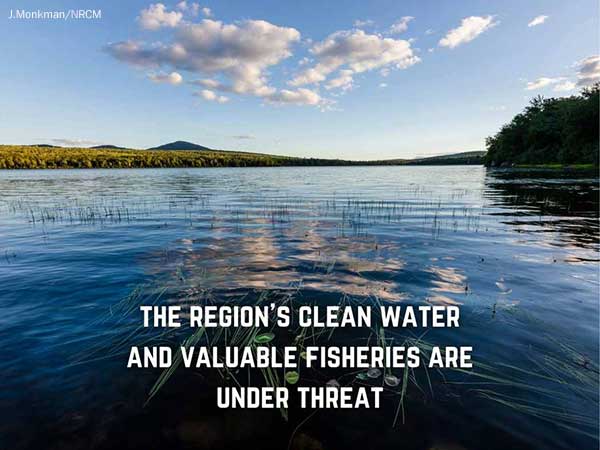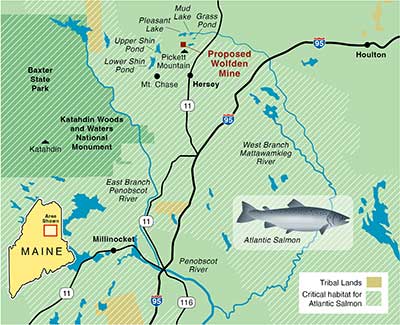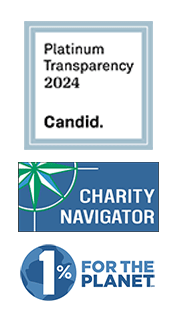We did it! Together, we stopped Wolfden Resources’ proposal for a polluting mine in the Katahdin region.
This win helps to protect the future of our clean water, habitat for brook trout and Atlantic salmon, supports the outdoor recreation economy, and helps us build the future we want for Maine.
We are honored to stand alongside the Penobscot Nation, Houlton Band of Maliseet Indians, Conservation Law Foundation, Maine Audubon, Earthjustice, local businesses and conservation groups, and more than a thousand Mainers who took action. This victory belongs to us all, thank you!
The Katahdin Region is No Place to Put a Mine
An untested and underfunded company, Canada-based Wolfden Resources Corporation, Inc. proposed building a zinc metal mine at Pickett Mountain, in the shadow of Baxter State Park and the Katahdin Woods & Waters National Monument.
The Katahdin region’s wild beauty and pristine water are extraordinary. This ecologically important area holds cultural significance to the Wabanaki tribes and keeps local outdoor recreation companies and sporting camps in business.
On February 14, 2024, Maine's Land Use Planning Commission voted (5-2) to deny Wolfden's proposal for Pickett Mountain. In late March 2024, we received word that Wolfden Resources chose not to appeal the LUPC decision to reject the Katahdin region mining proposal. This means the project is officially dead, locking in an enormous victory for Maine’s North Woods and the outstanding clean water in the region.
Protecting Maine’s North Woods
 The area Wolfden wants to mine is next to three State Heritage Fish Waters and is a centerpiece of the region’s essential outdoor economy.
The area Wolfden wants to mine is next to three State Heritage Fish Waters and is a centerpiece of the region’s essential outdoor economy.
It contains the headwaters of the West Branch of the Mattawamkeag River, which is sacred to the Penobscot Nation and provides key, federally designated critical habitat for endangered Atlantic salmon.
The region is just miles away from two of Maine’s most popular public lands, the Katahdin Woods & Waters National Monument and Baxter State Park. These iconic landmarks provide the foundation for economic activity in local communities and hold important historical and cultural significance to the Wabanaki Tribes and Maine people.
Overwhelming Opposition to Wolfden’s Proposal
 The Houlton Band of Maliseet Indians, the Penobscot Nation, and the Natural Resources Council of Maine, represented by Earthjustice and Brann & Isaacson, have joined the Conservation Law Foundation in petitioning to intervene in the review of Wolfden’s permit application to the Land Use Planning Commission (LUPC) to rezone the area for industrial uses.
The Houlton Band of Maliseet Indians, the Penobscot Nation, and the Natural Resources Council of Maine, represented by Earthjustice and Brann & Isaacson, have joined the Conservation Law Foundation in petitioning to intervene in the review of Wolfden’s permit application to the Land Use Planning Commission (LUPC) to rezone the area for industrial uses.
As part of the review process, the LUPC conducted formal hearings on Wolfden’s request including expert witness testimony. LUPC staff then made a recommendation to LUPC Commissioners to deny Wolfden's request for rezoning. The LUPC Commissioners voted on February 14, 2024, to accept the staff's recommendation and deny the request.
See a list of all groups opposed to Wolfden's proposal.
Wolfden Can’t Be Trusted
The proposed zinc mine at Pickett Mountain is being pursued by a virtually unknown Canadian company, Wolfden Resources, that has never operated a mine before. Many of its claims are not credible. For example, Wolfden has said it would treat wastewater more effectively than any mining company on earth—even though it has never operated a mine, ever.
After being forced to withdraw its initial request because it was riddled with errors, Wolfden submitted a second rezoning petition in January that sparked another review by the LUPC.
Comments by Wolfden’s CEO have demonstrated contempt for the region and those who value it by disrespecting Maine Tribes and mining laws have prompted outrage from the Penobscot Nation, Houlton Band of Maliseet Indians, and conservationists. The company has lost tens of millions of dollars over the past decade.
Learn More
- Read "Maine Voices Opposed to Wolfden's Mining" blog, including quotes from some of the 1,000+ public comments submitted to the Land Use Planning Commission in opposition to the Katahdin region mine.
- Read our two-page fact sheet
- Read "Your Questions Answered: Wolfden's Proposed Pickett Mountain Mine," by NRCM Forests & Wildlife Director Melanie Sturm
- Editorial: Metal mining has no place in the future of Katahdin region by Portland Press Herald editorial board
- Commentary: The Katahdin region is no place for a large mining operation by Chief Clarissa Sabattis and Chief Kirk Francis
- Commentary: Mining in the Katahdin region could endanger Maine's outdoor economy by Jen Brophy, owner of Red River Camps in Deboullie Township and Igor Sikorsky, owner of Bradford Camps on Munsungan Lake
- Opinion: Proposed mine in Katahdin region would harm cherished trout, salmon fisheries, by Rep. Bill Bridgeo
- News release: Maine Tribes and Leading Environmental Organizations Join Forces to Oppose Proposed Mine in Shadow of Katahdin
- News release: Wolfden Revives Failed Plan to Mine in Shadow of Katahdin
- Blog: Wolfden Withdraws Mining Application after Strong Rebuke from LUPC
- To access documents related to Wolfden's original rezoning petition, click here, and sign in with user name doc and password mejuri1
Groups Opposed to Wolfden's Proposal for Pickett Mountain
- Houlton Band of Maliseet Indians
- Penobscot Nation
- Bradford Camps
- Chandler Lakes Camps and Lodge
- Citizens Against Residential Mining Activity
- DarkSky International
- Dark Sky Maine
- Friends of Cobscook Bay
- Maine Brook Trout Project
- Maine Chapter of Native Fish Coalition
- Maine Wilderness Guides Organization
- Mt. Chase Lodge
Banner photo: Pickett Mountain (left), Mt. Chase, and Pickett Mountain Pond in Patten, by J.Monkman/NRCM












